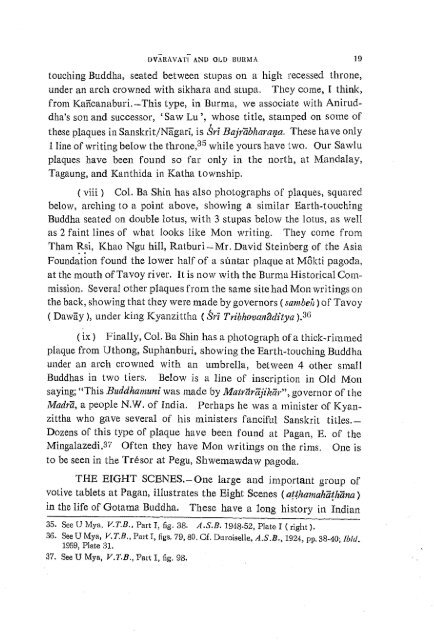The Journal of the Siam Society Vol. LIII, Part 1-2, 1965 - Khamkoo
The Journal of the Siam Society Vol. LIII, Part 1-2, 1965 - Khamkoo
The Journal of the Siam Society Vol. LIII, Part 1-2, 1965 - Khamkoo
Create successful ePaper yourself
Turn your PDF publications into a flip-book with our unique Google optimized e-Paper software.
DVARAVA'l'f AND OLD BURMA 19<br />
touching Buddha, seated between stupas on a high recessed throne,<br />
under an arch crowned with sikhara and stupa. <strong>The</strong>y come, I think,<br />
from Kaficanaburi.-This type, in Burma, we associate with Aniruddha's<br />
son and successor, 'Saw Lu ', whose title, stamped on some <strong>of</strong><br />
<strong>the</strong>se plaques in Sanskrit/Nagari, is Sri Bajrabharava. <strong>The</strong>se have only<br />
I line <strong>of</strong> writing below <strong>the</strong> throne,3 5 while yours have two. Our Sawlu<br />
plaques have been found so far only in <strong>the</strong> north, at Mandalay,<br />
Tagaung, and Kanthida in Katha township.<br />
(viii) Col. Ba Shin has also photographs <strong>of</strong> plaques, squared<br />
below, arching to a point above, showing a similar Earth-touching<br />
Buddha seated on double lotus, with 3 stupas below <strong>the</strong> lotus, as well<br />
as 2 faint lines <strong>of</strong> what looks like Mon writing. <strong>The</strong>y come from<br />
Tham Rsi, Khao Ngu hill, Ratburi-Mr. David Steinberg <strong>of</strong> <strong>the</strong> Asia<br />
Found~tion found <strong>the</strong> lower half <strong>of</strong> a suntar plaque at Mokti pagoda,<br />
at <strong>the</strong> mouth <strong>of</strong>Tavoy river. It is now with <strong>the</strong> Burma Historical Commission.<br />
Several o<strong>the</strong>r plaques from <strong>the</strong> same site had Mon writings on<br />
<strong>the</strong> back, showing that <strong>the</strong>y were made by governors ( sambeit) <strong>of</strong> Tavoy<br />
( Daway ), under king Kyanzittha (Sri Tribhovartaditya ).36<br />
( ix) Finally, Col. Ba Shin has a photograph <strong>of</strong> a thick-rimmed<br />
plaque from Uthong, Suphanburi, showing <strong>the</strong> Earth-touching Buddha<br />
under an arch crowned with an umbrella, between 4 o<strong>the</strong>r small<br />
Buddhas in two tiers. Below is a line <strong>of</strong> inscription in Old Mon<br />
saying; "This Buddhamuni was made by Matrarajikar", governor <strong>of</strong> <strong>the</strong><br />
Madra, a people N.W. <strong>of</strong> India. Perhaps he was a minister <strong>of</strong> Kyanzittha<br />
who gave several <strong>of</strong> his ministers fanciful Sanskrit titles.<br />
Dozens <strong>of</strong> this type <strong>of</strong> plaque have been found at Pagan, E. <strong>of</strong> <strong>the</strong><br />
Mingalazedi.37 Often <strong>the</strong>y have Mon writings on <strong>the</strong> rims. One is<br />
to be seen in <strong>the</strong> Tresor at Pegu, Shwemawdaw pagoda.<br />
THE EIGHT SCENES.-One large and important group <strong>of</strong><br />
votive tablets at Pagan, illustrates <strong>the</strong> Eight Scenes ( at~hamah'ii!hana)<br />
in <strong>the</strong> life <strong>of</strong> Gotama Buddha. <strong>The</strong>se have a long history in Indian<br />
35. See U Mya. V.T.B., <strong>Part</strong> I, fig. 38. A.S.B. 19·18-52, Plate I (right).<br />
36. See U Mya, V. T.B., <strong>Part</strong> I, figs. 79, 80. Cf. Dt~roiselle, A.S.B., 1924, pp. 38-40; Ibid.<br />
1959, Plate 31.<br />
37. See U Mya, V.T.B., <strong>Part</strong> I, fig. 98.

















